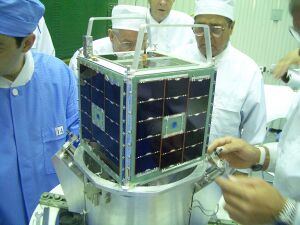Engineering:AO-51
 | |
| Mission type | Amateur radio |
|---|---|
| Operator | AMSAT-NA |
| COSPAR ID | 2004-025K |
| SATCAT no. | 28375 |
| Website | The Echo Project Page |
| Spacecraft properties | |
| Launch mass | 11.14 kilograms (24.6 lb) |
| Start of mission | |
| Launch date | 29 June 2004, 06:30:06 UTC[1] |
| Rocket | Dnepr |
| Launch site | Baikonur 109/95 |
| Contractor | ISC Kosmotras |
| Orbital parameters | |
| Reference system | Geocentric |
| Regime | Low Earth |
| Semi-major axis | 7,132.45 kilometres (4,431.90 mi) |
| Eccentricity | 0.0082657 |
| Perigee altitude | 702 kilometres (436 mi) |
| Apogee altitude | 820 kilometres (510 mi) |
| Inclination | 98.22 degrees |
| Period | 99.91 minutes |
| Epoch | 4 December 2013, 10:20:06 UTC[2] |
AO-51 is the in-orbit name designation of a now defunct (following battery failure) LEO amateur radio satellite of the OSCAR series; formerly known as ECHO, built by AMSAT. It was launched on June 29, 2004 from Baikonur Cosmodrome, Kazakhstan on a Dnepr launch vehicle. It is in sun synchronous low Earth orbit.
AO-51 contained an FM repeater with both 144 MHz (V band) and 1.2 GHz (L band) uplinks and 435 MHz (U band) and 2.4 GHz (S band) downlinks. It also contained a digital subsystem that transmitted telemetry on 70 cm and provided a complete PACSAT BBS that could be configured on both V band and S band uplinks. As well, there was a 10-meter PSK uplink.
AO-51 had four VHF receivers, two UHF transmitters, six modems, and 56 channels of telemetry. The two UHF transmitters were connected to four phased antennas, yielding right-hand circular polarization for the 435.300 downlink and left-hand circular polarization for the 435.150 downlink.
The AO-51 FM satellite was easily workable with an amateur radio VHF dual band hand-held radio, as long as you knew when the satellite's footprint was within reach. Transatlantic contacts had been made without much effort, as long as the satellite was approximately mid-Atlantic so that the edge of the satellites footprint was within reach on either continent.
As of May 2011 the satellite faced problems with the battery.[3] By September, a work around for the battery issue was found, bringing the repeater back in use. On November 29, 2011, the AO-51 Command Team announced that AO-51 has ceased transmission and is not responding to commands.[4]
External links
- AMSAT's ECHO Project page
- AO-51 Control Team News
- Satellite summary
- AO-51 Archive (Text-Only)
- AMSAT news about AMSAT 2006 Space Symposium
- ARRL Web Kid's Day Rules
- How to Work AO-51 with Your HT
References
- ↑ McDowell, Jonathan. "Launch Log". Jonathan's Space Page. http://planet4589.org/space/log/launchlog.txt. Retrieved 6 December 2013.
- ↑ Peat, Chris (4 December 2013). "AMSAT ECHO - Orbit". Heavens Above. http://www.heavens-above.com/orbit.aspx?satid=28375. Retrieved 6 December 2013.
- ↑ "ANS-126 AMSAT News Service Special Bulletin - AO-51 Batteries Failing". http://www.aus-city.com/ubbthreads/ubbthreads.php?ubb=showflat&Number=57786.
- ↑ Drew KO4MA. "Command Team and Operations Group AO-51 News". Archived from the original on 2012-01-25. https://web.archive.org/web/20120125010201/http://www.amsat.org/amsat-new/echo/CTNews.php.

